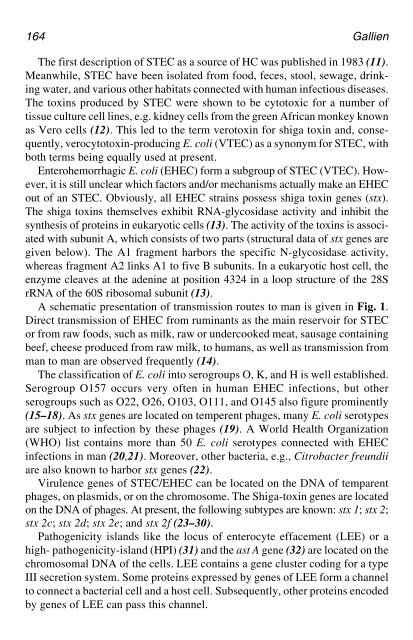PCR Detection of Microbial Pathogens PCR Detection of Microbial ...
PCR Detection of Microbial Pathogens PCR Detection of Microbial ...
PCR Detection of Microbial Pathogens PCR Detection of Microbial ...
Create successful ePaper yourself
Turn your PDF publications into a flip-book with our unique Google optimized e-Paper software.
164 Gallien<br />
The first description <strong>of</strong> STEC as a source <strong>of</strong> HC was published in 1983 (11).<br />
Meanwhile, STEC have been isolated from food, feces, stool, sewage, drinking<br />
water, and various other habitats connected with human infectious diseases.<br />
The toxins produced by STEC were shown to be cytotoxic for a number <strong>of</strong><br />
tissue culture cell lines, e.g. kidney cells from the green African monkey known<br />
as Vero cells (12). This led to the term verotoxin for shiga toxin and, consequently,<br />
verocytotoxin-producing E. coli (VTEC) as a synonym for STEC, with<br />
both terms being equally used at present.<br />
Enterohemorrhagic E. coli (EHEC) form a subgroup <strong>of</strong> STEC (VTEC). However,<br />
it is still unclear which factors and/or mechanisms actually make an EHEC<br />
out <strong>of</strong> an STEC. Obviously, all EHEC strains possess shiga toxin genes (stx).<br />
The shiga toxins themselves exhibit RNA-glycosidase activity and inhibit the<br />
synthesis <strong>of</strong> proteins in eukaryotic cells (13). The activity <strong>of</strong> the toxins is associated<br />
with subunit A, which consists <strong>of</strong> two parts (structural data <strong>of</strong> stx genes are<br />
given below). The A1 fragment harbors the specific N-glycosidase activity,<br />
whereas fragment A2 links A1 to five B subunits. In a eukaryotic host cell, the<br />
enzyme cleaves at the adenine at position 4324 in a loop structure <strong>of</strong> the 28S<br />
rRNA <strong>of</strong> the 60S ribosomal subunit (13).<br />
A schematic presentation <strong>of</strong> transmission routes to man is given in Fig. 1.<br />
Direct transmission <strong>of</strong> EHEC from ruminants as the main reservoir for STEC<br />
or from raw foods, such as milk, raw or undercooked meat, sausage containing<br />
beef, cheese produced from raw milk, to humans, as well as transmission from<br />
man to man are observed frequently (14).<br />
The classification <strong>of</strong> E. coli into serogroups O, K, and H is well established.<br />
Serogroup O157 occurs very <strong>of</strong>ten in human EHEC infections, but other<br />
serogroups such as O22, O26, O103, O111, and O145 also figure prominently<br />
(15–18). As stx genes are located on temperent phages, many E. coli serotypes<br />
are subject to infection by these phages (19). A World Health Organization<br />
(WHO) list contains more than 50 E. coli serotypes connected with EHEC<br />
infections in man (20,21). Moreover, other bacteria, e.g., Citrobacter freundii<br />
are also known to harbor stx genes (22).<br />
Virulence genes <strong>of</strong> STEC/EHEC can be located on the DNA <strong>of</strong> temparent<br />
phages, on plasmids, or on the chromosome. The Shiga-toxin genes are located<br />
on the DNA <strong>of</strong> phages. At present, the following subtypes are known: stx 1; stx 2;<br />
stx 2c; stx 2d; stx 2e; and stx 2f (23–30).<br />
Pathogenicity islands like the locus <strong>of</strong> enterocyte effacement (LEE) or a<br />
high- pathogenicity-island (HPI) (31) and the ast A gene (32) are located on the<br />
chromosomal DNA <strong>of</strong> the cells. LEE contains a gene cluster coding for a type<br />
III secretion system. Some proteins expressed by genes <strong>of</strong> LEE form a channel<br />
to connect a bacterial cell and a host cell. Subsequently, other proteins encoded<br />
by genes <strong>of</strong> LEE can pass this channel.






